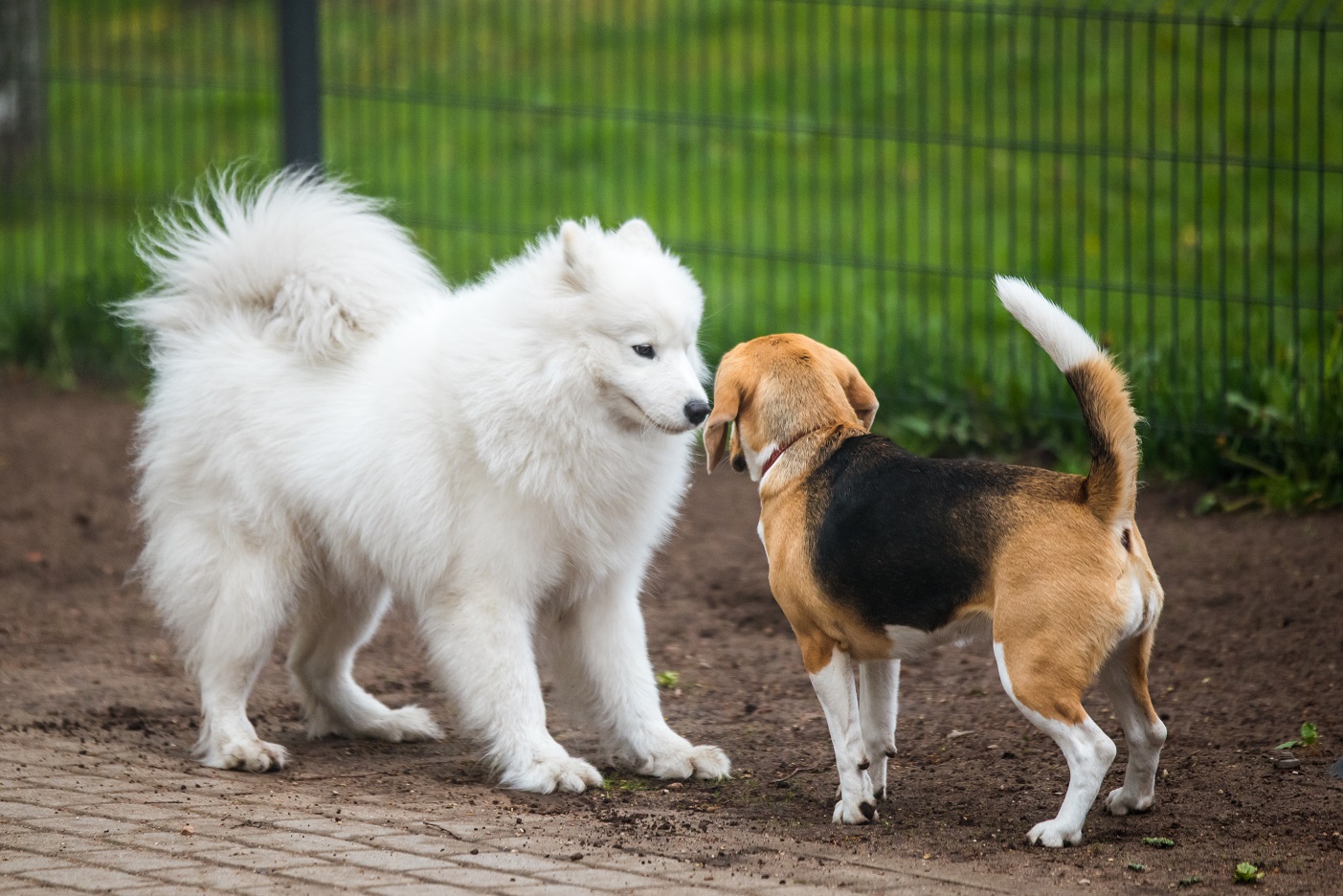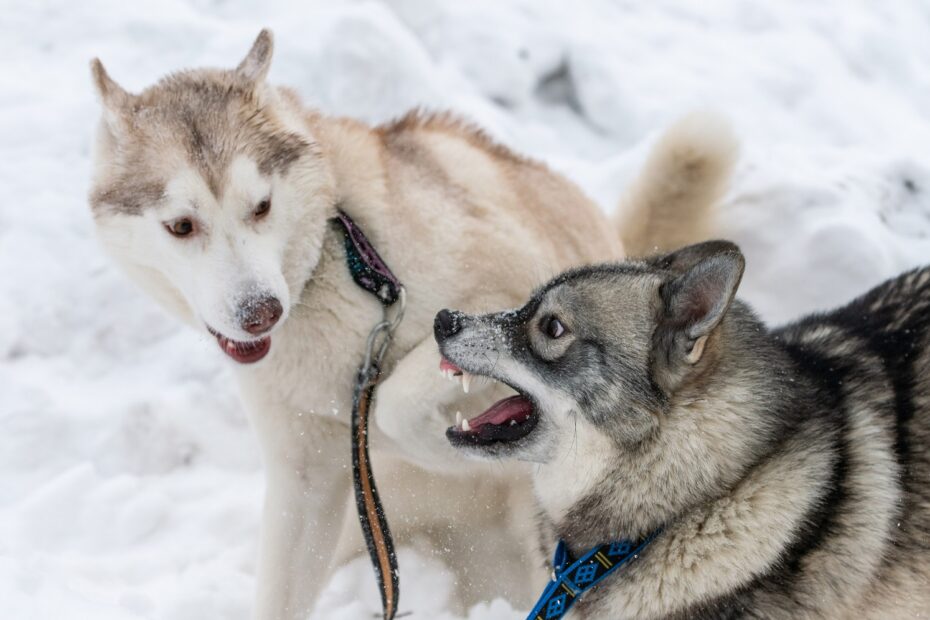Why do female dogs fight? If you live in a multi-dog household, it’s a question you’re probably all too familiar with.
While most of us tend to think of dog aggression as being a male problem, fights between female dogs are actually all too common… and all too frightening.
Maybe you’ve noticed one of your dogs pushing the other one aside whenever they want attention.
Perhaps the tension is palpable when they play together. Or maybe one of your dogs bullies the other by stealing all their toys or pushing them away from the food bowl.
Maybe one dog slinks around the house in an effort to avoid coming into contact with their nemesis. Perhaps things have escalated to growls, snapping, or even all-out war.
Whatever form the tension takes, it’s probably destroying any prospect you had of a harmonious household.
The worse thing? …this isn’t a problem that’s going to go away of its own accord. Your dogs aren’t going to wake up one day and decide it’s time for peace talks. Do nothing, and the fighting’s only going to get worse.
Fortunately, the situation isn’t hopeless. While fighting is a serious concern, there are several very effective strategies you can use to bring the bloodbath to an end.
To get the ball rolling, I’d recommend checking out the short video below from Dan Abdelnoor (aka Doggy Dan) over at The Online Dog Trainer.
During the video, Dan reveals what to do, but more importantly, what NOT to do when it comes to calming the aggressive tendencies in your dogs.
So watch the video, implement the training Dan recommends, and you’ll see a marked improvement in your dog’s ability to remain calm in any situation that triggers unwanted fighting.
Anyway, here’s the video link to take a look: Click Here To Discover How To Finally Stop Your Dogs Scary, Aggressive Fighting Problem… Even If You’ve Tried & Failed Before!
(video will open in new window)
Why Do Female Dogs Fight?
Dog-on-dog aggression is something no dog owner wants to face, but which countless numbers do. While it’s easy to think testosterone-ridden male dogs are the worst offenders, females can be just as bad.
In some cases, they can be even worse.
A household with two or more feisty females with conflicting personalities can be an incredibly tense place to be. Fortunately, the constant bickering and fighting you’re experiencing now doesn’t have to be forever.
To tackle the problem head-on, you’ll first need to identify what’s causing it. So, why exactly do female dogs fight?
Competing for Breeding Privileges
Unless she’s spayed beforehand, a female dog will hit sexual maturity somewhere between 12 and 36 months. As soon as that happens, all bets are off.
Your previously placid, friendly little pup will suddenly start experiencing hormonal mood swings, heat cycles, or even pregnancy.
If there’s another female in the house going through the same thing, they might start snapping and snarling at each other almost overnight. Even if they were BFFs before.
If there’s an intact male dog around, expect twice the trouble.
If one female senses she’s in competition with another for the right to breed with the male. She won’t bat her eyelashes and pout demurely in the hope of attracting his attention. She’ll do everything in her power to take the competition down.
Establishing Rank
Dogs that live together under the same roof constitute a pack. As with all packs, there’s a ranking system.
As the leader of the pack, the dogs won’t necessarily take issue with your status. They will, however, occasionally take issue with theirs.
In some households, the dogs will quickly decide on a pecking order. Once they do, the dominant dog will take the lead:
…If there’s a doorway to be walked through, they’ll go first.
…If there are toys to be played with, they’ll pick their favorite before anyone else.
…If there’s a particular spot that’s great for sleeping, it’s theirs, no questions asked.
In other households, it’s not so simple. If two dogs are of a similar status, a never-ending battle for supremacy is almost guaranteed.
This problem is often heightened as pack members age.
For instance, if a younger, subordinate dog senses that the older alpha’s positioning is weakening, they’ll start to feel confident enough to take them on.
The older alpha, meanwhile, may lash out more in an attempt to defend her status.
Possessiveness
Dogs can be insanely possessive. If they decide a toy, a bone, a sleeping spot, or even a person is valuable enough, they’ll go to extreme lengths to keep it all to themselves.
If another dog either doesn’t respect or doesn’t realize that certain things have already been claimed, clashes can all too easily break out.
Fear/Anxiety
Fear and anxiety can underpin more cases of aggression than you might realize.
If a dog feels anxious or threatened, they’ll usually try to get away from whatever it is that’s scaring them. If escape isn’t an option, they’ll try to make the scary thing go away instead.
Now, as you’d expect, that usually ends up in some very unpleasant behavior. As to what could be making your dog anxious, take your pick.
It could be that they weren’t probably socialized as a puppy and now find other dogs a source of fear rather than friendship. Maybe they’ve been bitten or frightened by other dogs in the past and have developed negative associations.
The possible reasons behind the fear are numerous. But whatever the cause, the outcome is usually the same.
Related Post: Help! My Dog Keeps Attacking My Other Dog For No Reason

How to Stop Female Dog Fights Before They Happen
When two female dogs clash, the results can be devasting. If neither of the dogs does anything to scale the aggression down, the worst fights can lead to serious injuries, even fatalities.
As soon as any tension is noted, it’s vital to step in with an approach that will minimize the risk of injury and restore order.
Although every dog is different and every case is unique, these general strategies will help across all scenarios.
Identify the Root Cause
To address a problem, you first need to figure out what’s causing it in the first place.
Take a step back and consider the circumstances around the aggression.
- Does one dog tend to initiate the aggression more than the other?
- Do fights break out over toys or food?
- Is the problem new or longstanding?
- Has one or both dogs recently hit sexual maturity?
The more you understand the context of the aggression, the better primed you’ll be to address it.
Visit the Vet
If the aggression between your dogs is new, pay a visit to the vet before anything else.
If an older alpha dog is getting weaker or becoming ill, a younger dog may be able to sense it and make a bid for power.
Certain conditions such as endocrine disorders can also contribute to sudden and unwelcome changes in behavior.
If your vet doesn’t identify a medical problem, let them know what’s happening and the extent of your concerns.
If the fights have escalated to beyond the point you feel you can manage, they may be able to refer you to a certified applied animal behaviorist.
Utilize Separation Management
If your dogs don’t get on, don’t think that forcing them to spend more time together will rekindle the love. The only thing that enforced contact is likely to achieve is blood and tears.
To keep any opportunities for fights and injuries to a minimum. Work to reduce contact between the two dogs as much as possible.
Exercise them separately, feed them individually, and avoid giving them toys or bones to share.
If you’re not on hand to supervise, be sure to crate them or keep them separated in different rooms or runs. Secure barriers to keep them apart should also be used when and where necessary.
To maintain their quality of life, be sure to rotate them, so they each get to spend an equal amount of time interacting with you and the rest of your family.
Separating the dogs might sound like you’re avoiding the problem rather than addressing it. But it’s not a cop-out.
Keeping your dogs separated doesn’t just reduce the immediate risk of injury. It keeps them out of the habit of fighting.
Considering that every fight is a major setback that will only make the problem worse and more ingrained, that in itself is a major step forward.
Practice Emotional Control
Dogs who display aggressive tendencies all stand to benefit from learning emotional control. Easier said than done, you might think. In fact, it’s not as complicated as you might imagine.
The techniques Dan demonstrates in the short video below will go a long way to helping your dog calm down and focus, regardless of what kind of distractions are happening around them.
So if you want to reduce the tension in the house, these exercises will help you do just that.
(video will open in a new window)
Try Some Counterconditioning
Counterconditioning involves changing your dog’s association with a certain thing from negative to positive. As dogs are ruled by their tummies, the easiest way to do this is with some high-value treats.
First of all, determine which of your dogs is the aggressor.
Next, figure out how far apart they can be from the other dog without reacting.
This is their threshold distance. During the early stages of the training, be very careful to respect the threshold.
Whenever the other dog approaches the threshold, start dishing out the treats. The idea is to get the aggressive dog to associate the other dog with something positive.
Very gradually, work on reducing the distance between the two until they can comfortably pass each other by with no reaction.
Counterconditioning is by no means a quick process. Trying to push your dog beyond a pace they’re comfortable with will only set your progress back.
But with perseverance and patience, you should notice a huge improvement.
Reward Polite Behavior
Punishing dogs for bad behavior is always a bad idea. Heaping aggression onto aggression never has and never will achieve anything good.
Rewarding good behavior, on the other hand, is one of the best ways of changing behavior for the better.
Instead of reinforcing your dog’s bad behavior with your attention, focus on rewarding polite, good behavior. The more your dogs start to associate certain actions and behaviors with a prize, the more they’ll favor them.
Make Training a Priority
Most of us are enthusiastic about training when dogs are puppies. But it’s easy to become complacent as they get older.
While that’s natural enough, a laissez-faire approach to training won’t cut it when you’re dealing with female dog fights.
If a dog with no aggressive tendencies doesn’t respond to instructions like “Leave it” or “Stay,” it’s not the end of the world. If a dog with even a hint of aggression doesn’t, it’s a problem.
If you haven’t already made a place for basic obedience training in your schedule, now’s the time to do it.
In addition to this, complement the training with the training techniques Dan demonstrates from The Online Dog Trainer I mentioned earlier.
Dogs need to be able to respond to commands regardless of distractions. And the only way they’ll be able to do that is if they’re in control of their emotions.
Dan’s training will help ensure they are.
Consider Spaying
When a female dog reaches sexual maturity, their hormones start kicking in in a big way.
If they’re the sole female in the household, that doesn’t necessarily spell trouble. If they’re not, it all too often ends in problems, particularly if there’s an intact male nearby.
Spaying will help take care of most kinds of hormonally driven aggression… but beware of setting your expectations too high.
Some dog owners think that spaying will eliminate all forms of aggression with one quick flick of the scalpel.
In short, it won’t.
If your dogs fight over possessions, in fear, or as a result of rank drive. The fighting is likely to continue long after the hormones have gone.
Related Post: Does Spaying Calm A Dog Down? – The Truth About Spaying Your Dog

Wrapping Things Up
Fighting amongst female dogs is a problem all too many dog owners face.
When you’re constantly on edge waiting for the next fight to break out, there’s no doubt it’s hard to maintain a sense of perspective. But don’t give up.
Aggressive tendencies might be challenging to deal with, but challenging doesn’t mean impossible.
Identify the problem, determine the correct solution, and with perseverance and consistency, you should soon notice a change for the better.

